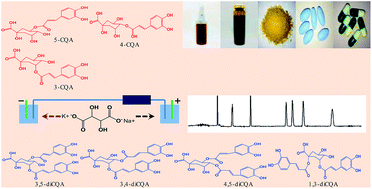Separation and quantitation of isomeric caffeoylquinic acids in honeysuckle products by low-pH microemulsion electrokinetic chromatography using tartrate as a chiral selector
Abstract
An improved microemulsion electrokinetic chromatography (MEEKC) method for the simultaneous determination of seven caffeoylquinic acids (CQAs) in honeysuckle-related products was reported. Multiple additives significantly affected the separation of CQA isomers, but adding 20 mmol L−1 chiral potassium sodium tartrate most significantly improved the separation and enabled short analysis time (within 22 min). The results indicated that tartrate could be an alternative additive for the rapid separation and quantification of CQA isomers. A low-pH phosphate buffer (pH 2.25) was also used to maintain the stability of CQA and suppress electroosmotic flow. Three monoCQA and four diCQA achieved good baseline separation under the optimal conditions. The limits of detection (S/N = 3) and limits of quantitation (S/N = 10) ranged within 2.0–4.6 and 6.8–15.4 μg mL−1, respectively. Validation showed that this simple MEEKC had feasible accuracy and precision. The developed method also successfully quantified seven CQA isomers in 13 solid (tablet, capsule, and granula) and liquid (injection and oral liquid) pharmaceutical preparations of honeysuckle.


 Please wait while we load your content...
Please wait while we load your content...